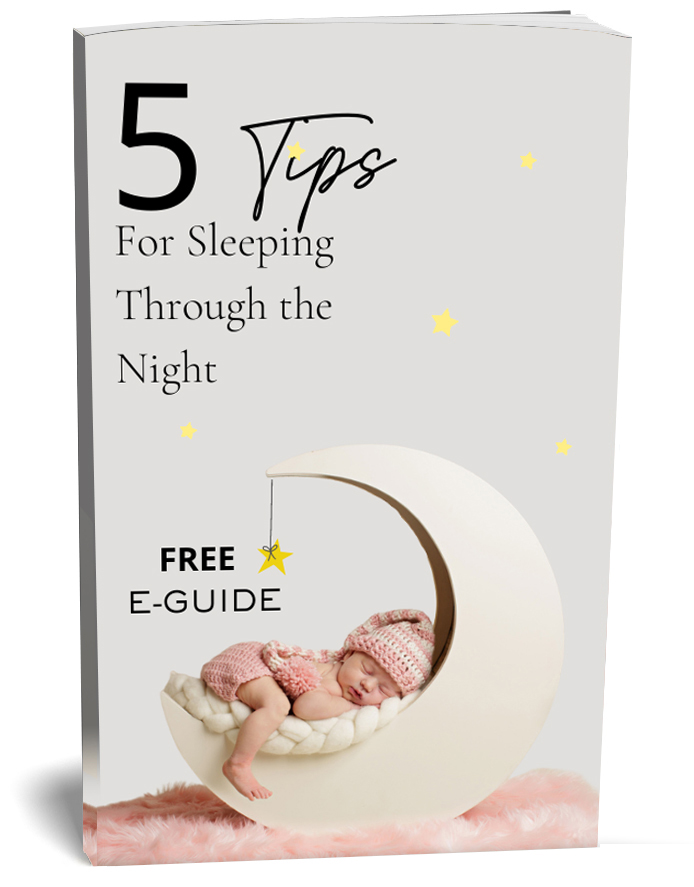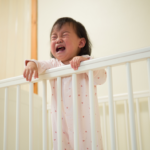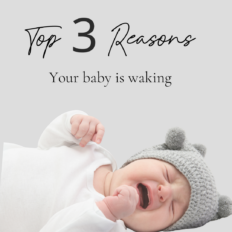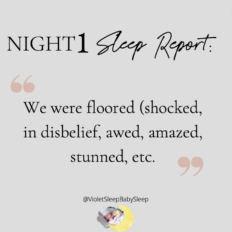
You felt like you finally had it figured out… the bane of every new parent’s existence, your baby’s sleep schedule. Then, it all flies out the window and your baby is fussy, waking up multiple times a night, and naps very little or not at all. You are not alone. A baby sleep regression, when your baby’s sleep patterns change, is super frustrating but not at all uncommon. Knowing why sleep regression happens can help you figure out the best way to get back to quiet slumber for you and baby.
Reasons for Baby Sleep Regression
There are a few different reasons why your baby’s perfect sleep has flown out the window. Take a look at a few:
- Baby learning to sleep (4 month regression)
- Development of sleep cycles (4 month regression)
- Developmental changes (8, 12, 18 month regression)
Although, your baby’s sleep regression may feel like forever when you’re in the midst of it, these lapses in sleep normally only last from two to four weeks.
Two of the most common reasons for sleep regression are changes in your baby’s sleep cycle or a developmental change. Let’s take a look at what happens during each of these changes.
Baby Sleep Cycle Changes
Around 4-months, your little one will experience some pretty big changes in their sleep cycle and that means you’ll probably see some pretty big changes in their sleep.
There are four cycles of sleep but in the first few months of their lives, babies only cycle through two of those stages and those are the deeper sleep stages. Around 4-months, your little one starts to cycle through all four stages, including lighter sleep. So, what many might think of as sleep regression is actually just your baby learning to transition through all of the sleep cycles rather than just two.
Older babies, children, and adults cycle through the stages very easily with little to no waking up. Younger babies, though, can start to wake up during these cycle changes. This is especially a problem if your little one hasn’t learned to go to sleep independently.
If you’re rocking your sweet baby to sleep every time you put them down, they’re going to expect you to be there to do the same when they jolt awake in the middle of a sleep cycle transition.
If your baby is in this boat, all is not lost, but it is time to help them go to sleep independently. You don’t have to get rid of all cuddle time pre-nap or bedtime but you do need help your little one figure out how to get themselves to sleep. Here are some ideas to get you and your little one on the right track and get through those sleep cycles independently.
![]() Put your little one down when they are drowsy but still awake.
Put your little one down when they are drowsy but still awake.
![]() Keep the room dark when it’s time to sleep. Sleep shades or even just a dark sheet over the window are great options to keep the light down.
Keep the room dark when it’s time to sleep. Sleep shades or even just a dark sheet over the window are great options to keep the light down.
![]() Set a nap/bedtime routine. Maybe you read a book or sing a song, say a few words. Whatever your routine is, keep it the same each time.
Set a nap/bedtime routine. Maybe you read a book or sing a song, say a few words. Whatever your routine is, keep it the same each time.
Besides getting used to all four sleep stages, your little one is also becoming much more aware of the world around them. This means they would much rather be awake than asleep making sleep sometimes the last thing on their little agenda.
As if all of that weren’t enough, there’s also a growth spurt around four-months, so don’t be afraid to feed your little one a few more times if it seems like that will help.
Finally, don’t be afraid to give some extra snuggles during this regression. Even though you’re probably exhausted, it’s a pretty overwhelming time for your little one as well. Extra snuggles from mom never hurt anyone.
If that were the only baby sleep regression you had to worry about, life would be easy. Unfortunately, you’re likely to see a few more times where your little one’s sleep suddenly goes out the window. These are most likely due to developmental changes.
Baby Developmental Changes
Developmental changes are fun and exciting, right? It means your little one is growing and changing right before your eyes. While the developmental changes are fun, the sleep regression that may come with them is not.
It’s not unusual for a positive developmental change to coincide with a baby regression in another area, like sleeping. So, while your little one might be so excited about learning to sit up, it might cause their sleep to take a turn for the worse.
Here are the times you’re more likely to see developmental changes in your baby in addition to the changes at 4-months.
- 8 to 10-months: Learning to crawl, pull up to standing
- 12-months: Possibly walking and talking
- 18-months: Increase in vocabulary
Keep in mind; babies reach developmental milestones at different rates so these ages might not be exact.
The best solution to dealing with developmental changes causing sleep regression is to help your little one master those skills when they’re awake. It’s also helpful if your little one knows how to go to sleep independently, as we mentioned above.
Sleep, Baby, Sleep To The Rescue!
A baby sleep regression is confusing and frustrating. If this all seems too overwhelming or what you’re trying isn’t working, I’m happy to help. I specialize in teaching babies to sleep independently and can help you and your little one reach sweet slumber once again.





















